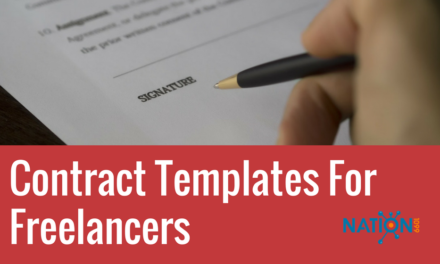Dealing with the ebb and flow of freelance finances is one of the biggest challenges of building a business as a freelance consultant or solopreneur. Sending multiple invoices, tracking down late payments, and juggling bills while you wait for that “check in the mail”? If that sounds like you, it’s time to think about requesting upfront payment from clients.
Getting upfront payment for freelance or consulting work is a common industry practice, especially for bigger projects. But negotiating it can be tricky, and a lot of new freelancers are nervous to ask. They don’t want to jeopardize work from a new client or put additional obstacles in the way of landing the gig.
Many freelancers new to the gig economy feel awkward talking about money. But getting better at this is a necessary part of growing your freelance business. The conversation about payment terms is also one of the most important that an independent contractor will have with clients, over and over again. Whether you’re just getting started freelancing or have been at it for years, here’s how to ask for an upfront payment gracefully and effectively.
Upfront payments make everything better
We interview experts for our weekly advice show on many different topics — negotiation, contracts, pricing, marketing — and one tactic keeps coming up . . .
. . . upfront payments, sometimes called tiered contracts.
We have come to realize that this one change in the way you work with clients has a ripple effect that improves many other aspects of your business. When you get an advance payment:
- You’ll be perceived as more professional.
- Projects stay on schedule, because clients want to get what they’re paying for.
- Communication improves, because clients take time to read your contract when they have to send a payment right away.
- You will feel less vulnerable because you have secured some of the payment.
- Your overall client mix gets better because you are weeding out the flakes and dealing with serious buyers.
- Better cash flow opens up options to following all the other advice freelancers get — hiring VAs, saving for retirement, investing in marketing, investing in a better freelance website, etc.
What is an upfront payment?
An upfront payment for an independent contractor can be defined as payment received before work begins. A freelance contract typically specifies the payment terms and the timeline. If you don’t have an agreement to pay upfront, then work will usually start immediately when the contract is signed or according to some other schedule outlined in the contract. When paying upfront is specified, the clock on the project schedule starts when the contractor receives the payment.
For the purposes of accounting, upfront payment has a more specific definition having to do with recording it as a liability or an asset, depending on when services are delivered. You should check with your accountant about how to record an upfront payment, but don’t let that keep you from negotiating for one.
What are the benefits of getting payment in advance?
The benefits of an upfront payment to you as a freelancer are probably pretty obvious:
- It helps you manage your cash flow because you’re not stuck waiting for a late check.
- It covers out-of-pocket expenses you incur during the gig without having to dip into savings.
- It takes the stress out of getting paid for your work and protects you from clients who don’t pay.
One benefit of an upfront payment that you may not expect is that it protects you from clients aren’t really serious about the project. Once they have skin in the game, they are less likely to be likely to be a bottleneck during the project, and they are more likely to put in the effort needed on their behalf to make the project a success. They are more likely to be clear about their objectives and less likely to make sudden strategic changes in the middle.
That doesn’t necessarily impact your revenue in the short term, but it matters over the long-term. Unsuccessful projects, even if it’s because the client has changed direction and not because of the quality of your work, will be a drag on your portfolio.
These are nice benefits, but when you’re trying to negotiate an upfront payment from a new client, they’re going to want to know what’s in it for them.
A lot, it turns out.
First off, when a client has paid upfront, they can be sure they won’t have any surprises when they receive the invoice. The transparent pricing means they can finalize their budget, and have better control over final project costs.
Second, it gives them security of mind to know their project will be a priority for you. (Especially if they’re in a rush.) Let your clients know that when they pay you upfront they’re reserving your time.
That’s something you wouldn’t be able to offer otherwise. After all, time you have set aside for one client is time you aren’t spending earning money on a different project. If you haven’t asked for an upfront payment, your budget could be in real trouble if the client you reserve time for doesn’t come through.
Finally, getting advance payment establishes a professional relationship between yourself and the client. It shows that you are running a high-quality business and expecting to give — and receive — professional treatment.
An upfront payment says, “I’m a business professional and I will deliver on what I have promised. When you require upfront payment, you’re making a professional impression by telling your client that you’re not hedging your bets, and neither should they.
Are there any disadvantages to getting paid in advance?
We can think of two disadvantages. One we mentioned already: it makes your accounting a little more complicated.
The second is how it can affect taxes for an independent contractor if the income and the expenses occur in two different tax years. For example, if you get a new client for a six-month contract in December and receive a large advance payment, your gross taxable income for that year will have a big spike. But the corresponding spike in your expenses will probably happen in the following tax year.

As a result, your net income could be out of whack for each year. In the earlier year, your estimated quarterly tax payments will have been too low, and you’ll a big tax payment with your return in April. It should balance out the following tax year when your expenses are relatively higher, but it’s a long wait for that refund.
[If any readers have insight on how to manage this scenario, leave us a comment or contact us. We’d love to get your perspective.]
There are a few different ways to arrange and negotiate for upfront payments, and each is more familiar in some industries than others. Here are the four most common scenarios.
1. Ask for 100% upfront payment
This is just what it sounds like: The client pays you 100 percent of your negotiated fee before you begin work at all. This requires the project to have a fixed scope that’s been signed off by the client, so that you and your client both know what to expect going in.
If you suspect the possibility of scope creep, you may want to consider a more flexible payment plan or offer a series of additional paid services the client can add on if the project expands.
Benefits of the 100% advance payment: Your client knows exactly what everything will cost upfront; you know you will get paid for the work.
2. Require a deposit to start work
An alternate way of securing an upfront payment is by requiring a deposit. Typically, a deposit would be 25 or 50 percent upfront, and the deposit is due when the contract is signed (and before any work is started).
Typically, your contract will state that you retain copyright to your work (or you will hold on to the usable files) until after the balance of the contract is paid. This helps ensure you get paid for your work. This model is common with freelance web development and freelance software development.
A variation on this is to require an upfront payment for a set of actual expenses that you will incur at the beginning of the project. If your specialty requires that you buy materials to begin work, you might get a deposit equal to that amount. This is more common when a project proposal itemizes all the expenses for materials, subcontractors, etc.
Benefits to the upfront deposit: Your client can spread their budget over multiple payments while still reserving your time; you know that your client is serious and ready to start work.
3. Break the project fee into milestone payments
An alternate to the deposit method of upfront payments is requiring milestone payments. This is especially effective for a longer project, say a website development that might take six months. You could negotiate an initial deposit, then split up the remainder of the payments to be due at certain milestones or deliverables. That helps keep the work on track.
The trick is to avoid having those milestones be dictated by the client’s timeline. You don’t want to be waiting to receive payment because the project is caught up in the client’s review process, or they’re dragging their feet on getting you the right materials. This is why we’re big fans of including a “client responsibilities” section of the scope of work.
Work with your client to come up with a project scope that has solid deadlines, and tie milestone payments to those deadlines. That way you can be sure you’re turning in your work at the agreed time, and getting paid whether or not the client is keeping up with you.
Benefits of the milestone payment approach: The client can spread out their budget; you can count on a steady flow of revenue.
4. Bill ahead for time worked — the retainer model
If your business model is to bill for time worked rather than as a flat project fee, ask for upfront payment in the form of credit. The client pays for a certain number of hours ahead of time, and you deduct the number of hours you work from their initial payment.
This is essentially the monthly retainer model familiar in the world of legal work and financial advising. In effect, the client is reserving a certain minimum number of hours of your time per month. The advantage to them is that you are on call to jump in when you are needed.
This model is common for maintaining a completed or mature project. A freelance web developer might sell retainer-based services to keep upgrading and maintaining a company’s website. A freelance marketing professional might use this model after a marketing strategy is in place and underway.
Continue billing on this time-credit cycle as you go forward in the relationship. Go one step farther and set up your invoicing software to automatically invoice each month. Better yet, set up an automatic draft on your client’s account and skip the invoicing altogether.
Benefits to the retainer model: The client knows you’ll be available when they need you; you have a steady stream of income.
Addressing the trust issue
One of the biggest reasons clients hesitate to make upfront payments is worry that the freelancer won’t deliver. Maybe because of a bad experience in the past, or maybe out of inexperience working with freelancers.
Let your clients know that you’re running a professional business by having a solid online presence complete with references, testimonials, and LinkedIn recommendations. When potential clients see this social proof, they will feel more at ease about pay you for upfront work.
Reinforce this impression of trustworthiness during your initial communications with potential client. Be transparent and professional, articulate your value, and respond promptly to let them know they can count on you.
If you’re running a professional business but your potential client is hesitant to give you any sort of upfront payment, ask yourself why. It may be a sign of more red flags down the road.
Have you tried one of these methods to secure upfront payment from clients? How has it worked? Let us know in the comments.

Jessie Kwak author bio
Jessie Kwak is a freelance writer and novelist living in Portland, Oregon. She writes for B2B brands in educational technology, SaaS and related industries. You can learn more about her work at www.jlkwak.com.











Thank Jessie. This was really helpful. I’m using this as I get the business details of my business figured out like contracts, deposits, rates, etc. Lots of great information.
Great article. My question is how does it work with upfront deposits when you are working with an organization that is big enough that they pay out invoices after 30-60 days. Are these companies going to just shoot out your deposit right away? I have mostly worked with smaller clients so this has never been an issue, but now I am aiming for larger projects with bigger businesses and want to know how to handle this. Thanks!
Great question. You do risk running into some friction, but hopefully not as much as you’re anticipating. A few thoughts:
-Letting them know “I’ll start work when you pay the deposit” sends a signal that you’re serious. The lead contact — a front-line departmental manager usually — is eager to get work going because they have problems they need your help solving. If it’s important to them, then they’ll communicate to their colleagues in procurement or billing that it’s time sensitive.
-They may have a stated policy about paying “freelancers” but they almost certainly have a mechanism to pay other people and organizations quickly. Deposits via purchase orders are common for any contractor that has supplies, for example. If their offices have ever been painted, they paid a deposit to the painting contractor.
-Many front-line managers (or their immediate bosses) have a certain amount of purchasing authority via credit card. If so, Paypal is a quick way to get you paid. The fees might be a bite, but to secure the deposit you might feel the fee is worth it. If you’re using a subscription invoicing software like Quickbooks, you might have the option to receive payment via credit card already.
-On one occasion I did do something in-between for a project with a tight timeline. When the lead contact assured me the invoice for the deposit had been routed for payment, I started work even though the check hadn’t gotten to me yet. That worked out okay. It’s a risk, but if a couple weeks in the payment still hadn’t arrived, I’d be able to say “We agreed . . .” and have a rationale for pausing work.
Practically, though, it doesn’t often come to that.
Overall — and this ties into the articles about raising rates also — don’t assume you’re asking too much. I have yet to meet the truly accomplished and experienced freelancer who doesn’t have more sway with their clients than they think.